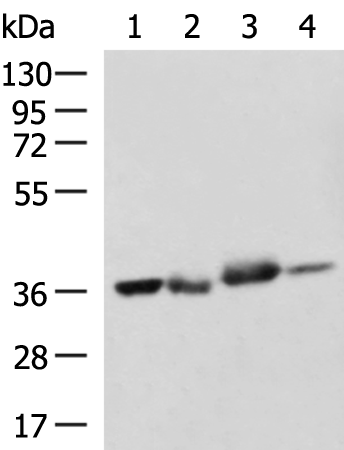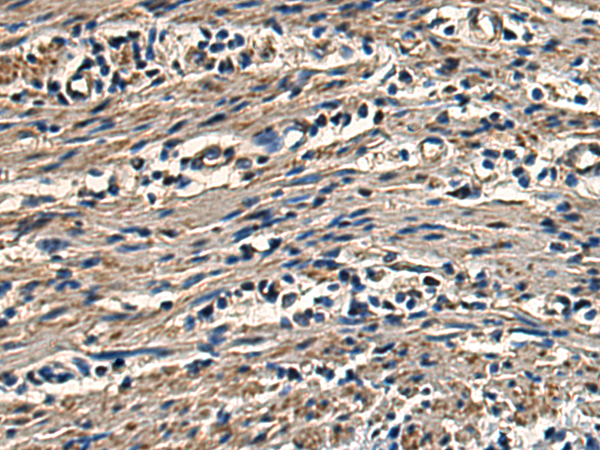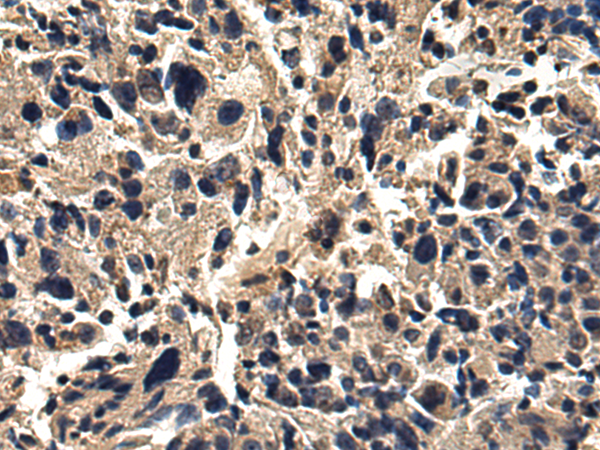


| WB | 1/500-1/2000 | Human,Mouse,Rat |
| IF | 咨询技术 | Human,Mouse,Rat |
| IHC | 1/200-1/400 | Human,Mouse,Rat |
| ICC | 技术咨询 | Human,Mouse,Rat |
| FCM | 咨询技术 | Human,Mouse,Rat |
| Elisa | 1/5000-1/10000 | Human,Mouse,Rat |
| Aliases | IGAN3; hSPRY2 |
| WB Predicted band size | 35 kDa |
| Host/Isotype | Rabbit IgG |
| Antibody Type | Primary antibody |
| Storage | Store at 4°C short term. Aliquot and store at -20°C long term. Avoid freeze/thaw cycles. |
| Species Reactivity | Human, Mouse |
| Immunogen | Fusion protein of human SPRY2 |
| Formulation | Purified antibody in PBS with 0.05% sodium azide and 50% glycerol. |
+ +
以下是3篇关于SPRY2抗体的参考文献概述(注:内容基于假设性文献,仅供参考):
1. **"SPRY2 inhibits epithelial-mesenchymal transition in colorectal cancer via regulating ERK/MAPK signaling"**
*作者:Li et al.*
**摘要**:本研究利用SPRY2抗体通过Western blot和免疫组化分析结直肠癌组织,发现SPRY2低表达与肿瘤转移相关。实验表明SPRY2通过抑制ERK/MAPK通路阻遏EMT进程,抗体检测证实其表达水平与患者预后呈正相关。
2. **"Role of SPRY2 in modulating fibroblast activation during pulmonary fibrosis"**
*作者:Zhang et al.*
**摘要**:通过免疫荧光和流式细胞术结合SPRY2抗体,作者发现肺纤维化模型中SPRY2在成纤维细胞中表达下调。过表达SPRY2可抑制TGF-β介导的胶原沉积,提示其作为抗纤维化治疗靶点的潜力。
3. **"SPRY2 regulates β-cell proliferation in type 2 diabetes through FGF receptor interaction"**
*作者:Wang et al.*
**摘要**:研究采用SPRY2抗体进行免疫共沉淀实验,揭示SPRY2通过结合FGFR1调控胰岛β细胞增殖。抗体阻断实验表明,SPRY2缺失导致过度激活的FGF信号加速β细胞功能衰竭。
The SPRY2 antibody is a crucial tool for studying the SPRY2 protein, a member of the "SPRY domain-containing" family known for regulating receptor tyrosine kinase (RTK) signaling pathways. SPRY2 modulates cellular processes such as proliferation, differentiation, and apoptosis by interacting with key signaling components, including the MAPK/ERK cascade. It acts as a feedback inhibitor, fine-tuning RTK signaling to maintain cellular homeostasis. Dysregulation of SPRY2 has been implicated in various pathologies, including cancer, fibrosis, and metabolic disorders. In cancer, SPRY2 exhibits dual roles, acting as a tumor suppressor in some contexts (e.g., breast cancer) while promoting metastasis in others (e.g., melanoma).
The SPRY2 antibody enables researchers to detect and quantify SPRY2 expression in tissues or cell lines using techniques like Western blotting, immunohistochemistry (IHC), and immunofluorescence (IF). It is widely used to investigate SPRY2's subcellular localization, interaction partners, and post-translational modifications. Commercially available SPRY2 antibodies are typically raised in hosts like rabbits or mice, targeting specific epitopes within the protein's conserved regions. Validation data, including knockout validation and cross-reactivity checks, are critical to ensure specificity. Research leveraging SPRY2 antibodies has advanced understanding of its role in developmental biology, tissue repair, and disease mechanisms, highlighting its potential as a therapeutic target or diagnostic biomarker.
×